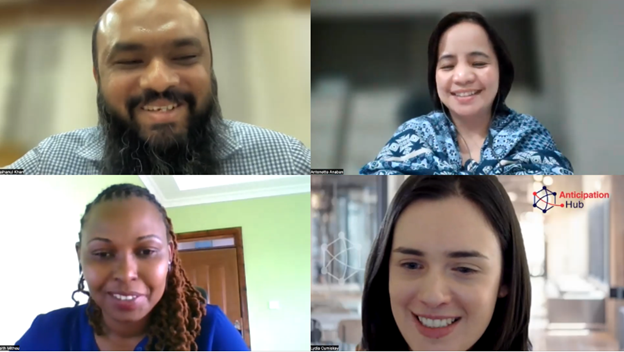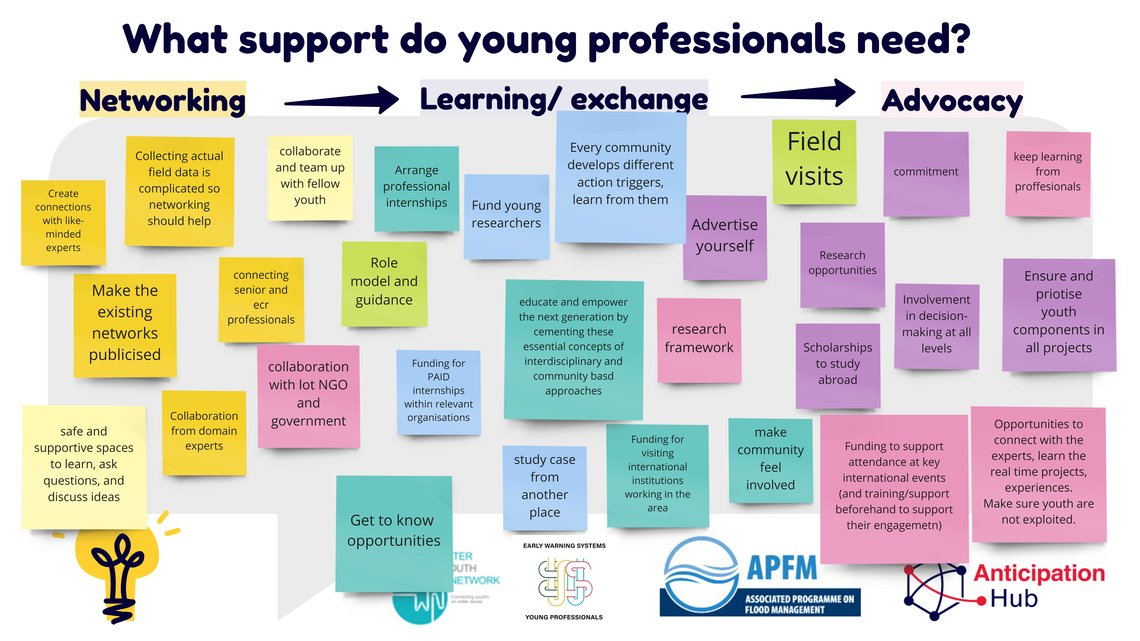Categories
From early warning to early action: inspiring & empowering the next generation
Young professionals and youth are the future leaders of early warning and early action. They have unique communication skills, are ready to innovate with the latest technology and bring their fresh energy and enthusiasm to the forefront of any challenge. But, what lessons have young professionals learned so far on their journey, where can they create lasting impact and what else is needed to ensure more youth and young professionals are empowered to embark on this journey?
To unpick the challenges and opportunities, the Water Youth Network, the Anticipation Hub and the Associated Programme on Flood Management brought young professionals together in a webinar marking World Meteorological Day 2022 to share their lessons and needs for joint action. The full recording of the event can be accessed here.
Where can young professionals and youth have the greatest impact?
Building interdisciplinary partnerships
Early career professionals and youth should engage in all aspects of disaster risk reduction and ensure that all components of early warning and early action systems are being developed in a balanced way. It is a complex system bringing together many actors, disciplines and sectors and future leaders need to be ready to work together to build bridges and break down silos to continuously collaborate and learn. Only through collaboration and partnership can we ensure that all at-risk communities can access early warnings and take early actions.
Youth have the power to collaborate and come together to generate ideas.
Ensuring an inclusive approach
A deep understanding of the diverse user needs is fundamental to enabling more inclusive and effective early warning and early action. Opportunities exist for youth and young professionals to proactively incorporate the needs, priorities and capabilities of marginalized gender groups, vulnerable groups and people with disabilities to amplify their voices in the design of early warnings and early actions. An example of this is the gender transformative flood early warning system in Baguio City Disaster Risk Reduction and Management Office, Philippines where youth can engage as volunteers and interns to gain experiences.
When you become a leader, make sure you give full support to the vulnerable and marginalized groups, understand that not all of them are open to raising their needs to the local government, and you can establish a channel to share their needs.
Being the connectors and communicators
Despite advances in science, forecasting and technology, warnings are still not reaching everyone in an understandable and actionable way. Youth and young professionals can help bridge this gap between science and practice by utilising their communication skills and promoting a community-led, bottom up approach to early warning and early action. For example, youth can be represented in community organized groups to serve as an intermediary between communities and local government. They can build capacity to work with local stakeholders and project implementers to ensure that warnings are understandable and actionable by all community members.
Experiences in Bangladesh show that warnings need to come from one authoritative source, be communicated in multiple mediums e.g. email, SMS, social media but also from trusted community members. Youth can play an important role in disseminating warnings to their families and social networks, and building their awareness of the risks faced and how to strengthen their capacity to manage them. In addition, youth can help to co-design early action plans hand-in-hand with communities to ensure they are tailored to their local needs.
We need to rethink our early warning early action connectors… and maximize the role that young people play to improve our communication through the state-of-the art technology.
Embedding innovation
Given the multi-disciplinary and complex nature of enabling early warning and early action, it requires continuous innovation that bridges communities' needs with technology and scientific advances. Youth in communities can support such innovation, for example through real-time collection of data that supports more accurate forecasting of future hazards. Young professionals and youth can also play a role in building an understanding of forecast uncertainty for decision making.
Young professionals’ innovative skills must be encouraged, nurtured and sustained through existing institutional structures, research and project implementation. Young professionals can stimulate change within hydromet and disaster management agencies and facilitate partnerships with science and practice to translate innovations into impact on the ground, as experienced in the FATHUM project.
Young professionals are also well-positioned to share their lessons with peers and facilitate cross-fertilisation of ideas and skills. Importantly, all youth and young professionals have a voice and can feel empowered by their actions, without necessarily needing to come up with something ‘new’ to translate early warning into early action.
Never feel you are a new kid in the town of early warning early action, early career professionals have huge potential to bring about positive change in the system and promote innovation - we do not need to reinvent the wheel, but make it more efficient.

What support do young professionals and youth need?
The panelists and participants identified multiple enabling and supporting mechanisms that can enhance the capacity of the current and next generation of early warning and early action professionals across multiple disciplines.
Expand leadership and employment opportunities for young professionals in disaster risk management and hydro-meteorological agencies to apply their skills and innovative ideas, including paid internships and collaborations with local universities.
Redefine the curriculum of university programmes to ensure students are exposed to real-life challenges in practice, strengthen their communication and interdisciplinary skill sets to devise solutions.
Increase access to practical learning, research and training opportunities that bridge science and practice within universities, international organizations and government agencies e.g. paid internships, funded joint research projects, and co-sponsored education scholarships.
Create supportive spaces for networking and exchange to inspire collaboration, enable connections with like-minded peers and seniors, and develop inter-disciplinary skills e.g. conferences, events and working groups.
Opportunities to co-create innovative and inclusive solutions that connect all components of early warning and early action - risk knowledge, monitoring and forecasting, communication and early action/ response.
Involve youth in projects and utilise their unique communication skills to communicate warnings, design early action plans, increase risk awareness and bridge local connections to empower vulnerable and marginalized groups, and meet their needs.
Collectively we have a responsibility to pave the way for current youth, students, young professionals and volunteers to advocate for these needs and ensure access opportunities. By investing in our future leaders, we can ensure that warnings are accessed, understood and acted upon by everyone at risk.

Opportunities for continued engagement
The webinar also announced the winners of the Global Integrated Flood and Drought Management Competition for #Youth-led projects. Erick Tamba Mnyali from the College of Science and Education Youth Mappers Tanzania presented his project on mapping flood protection zones and evacuation routes to improve preparedness and response capabilities to flash floods in local communities. Graziela Ariani Olua and team at the Indonesian Agency for Meteorology, Climatology, and Geophysics shared their project ‘AWAKE’ designed inclusively for children and people with disabilities to equip them with necessary knowledge on local hazards and skills to communicate and respond to warnings. WMO and GWP provide will funding and mentoring for the projects to be implemented with support from the Associated Programme on Flood Management and Integrated Drought Management Programme and the Water Youth Network will facilitate learning and exchange with others.
Furthermore, youth are at the core of the WMO Water and Climate Coalition which has a specific youth movement ‘UN1FY for Water and Climate’ endorsed by the WMO Secretary-General and the Office of the UN Secretary-General Envoy on Youth. Currently, WMO has 14 paid interns who are serving as the Regional Youth Focal Points to ensure youth are involved in processes and activities of the Coalition, and to organize a conference aiming to produce the Water and Climate Youth Development Plan and Agenda.
The Water Youth Network is now the 90th partner of the Anticipation Hub and they will work together to support early career engagement at the WMO Multi-hazard Early Warning Conference and at the Global Platform on Disaster Risk Reduction, taking place 23 - 27 May 2022.
The Water Youth Network invites young professionals to join the Disaster Risk Reduction team and to express interest in supporting partnerships with the Associated Programme on Flood Management, Integrated Drought Management Programme and the Anticipation Hub. Interested individuals are also invited to continue the conversation around inclusion in the Anticipation Hub protection, gender and inclusion in anticipatory action working group and sign up to the Anticipation Hub newsletter to receive the latest updates and opportunities.
This blog was written by Lydia Cumiskey (Anticipation Hub), Adele Young (Water Youth Network, EWS YP), Nivedha Elango and Alexia Calvel (Water Youth Network APFM focal points) and Ramesh Tripathi (WMO). For more information please contact lydia.cumiskey@germanredcross.de.
The full recording of the event can be accessed here.

